Skip to content

Image: Dominic Bayley / IDG
At a glance
Expert’s Rating
Pros
- Large 16-inch display with a tall 16:10 aspect ratio
- Very large keyboard with dedicated numpad
- Long battery life
- Plenty of space to stretch out in the chassis makes using it feel effortless
- Very lightweight and slim for its size
Cons
- Downward firing speakers lose some audio clarity
- The display quality is fine but not amazing
- Performance of the discrete Nvidia MX570 A GPU is lackluster among discrete GPUs for gaming
Our Verdict
The HP Pavilion Laptop 16 is a jack of all trades with a big display and comfortable spacious keyboard packed with options. It also has a long battery life and enough power to comfortably handle most leisure and office applications.
With a spacious keyboard and large, 16-inch display, the HP Pavilion Laptop 16 made all my general computing tasks so easy – from watching movies to browsing and just mucking about on social media and even running the odd office application. Nothing (except playing AAA games) seemed like hard work. It also had enough battery life to confidently see me through a whole day’s use. Read on to find out more.
Further reading: Best laptops 2024: Premium, budget, gaming, 2-in-1s, and more
HP Pavilion Laptop 16: Specifications
HP’s website shows you can configure your HP Pavilion Laptop 16 with different Intel Core Ultra processors up to the most powerful Core Ultra 7 155U. If you choose that option without any upgrades, your laptop’s graphics will be rendered by the processor’s Integrated Graphics chip, which should be suitable for lightweight tasks. That option comes with 16GB of onboard RAM.
The model I reviewed, however, had a step-up discrete GPU in the form of an Nvidia GeForce MX570 A. That upgrade costs $150 at checkout and comes with 32GB of onboard memory. My review unit’s other specifications included:
- CPU: Intel Core Ultra 7 155U
- RAM: 32GB DDR5 / 4800MHz
- Graphics: Nvidia GeForce MX570 A
- Display: 16-inch, WUXGA (1920 x 1200p), IPS-grade LCD, anti-glare, 16:10 aspect ratio, 300 nits peak brightness
- Storage: 512GB PCIe Gen 4 NVMe SSD
- Connectivity: 2 x USB-C 3.2 Gen 2, USB-A 3.2 Gen 1, USB-A 3.2 Gen 2, HDMI 2.1, 3.5 mm combo jack
- Networking: Wi-Fi 6E, Bluetooth 5.3
- Battery capacity: 59Wh
- Dimensions: 14.08 x 10.03 x 0.70 inches
- Weight: 3.97 lbs (1.80 kg)
- Cost: $769.99 as reviewed (starting price $619.99)
Looking at competitor models, the Pavilion Laptop 16 costs more than the Acer Aspire 3 (starting price $499,99). The Pavilion 16, however, has better graphics performance.
Compared to the Dell Inspiron 16 2-in-1 (starting price $999), the Pavilion Laptop 16 is the more affordable option, despite the two having similar benchmark performance. The Dell is a slightly more versatile option for using in different modes while the Pavilion’s large display makes for a more relaxed viewing experience.
HP Pavilion Laptop 16: Design and build
The HP Pavilion’s design benefits from its designation as a jack-of-all-trades laptop. As the all-rounder in HP’s lineup, it needs to be useful for a broad number of things – from leisure to light office work and even gaming. That balance has mostly been achieved.
For starters, like an ultrabook it’s very sleek with a low-profile so it can be the go-anywhere laptop you need it to be. If you want to throw it in a backpack and take it to work, college, or the library, or just move it from one room to another, the laptop’s 0.7-inch thin chassis and 3.97-pound weight makes that so easy. The 100W charger is also small and compact and ideal for carrying.
Yet like other portable laptops the HP Pavilion 16 feels anything but cramped. That balance between sleekness and space creates a casual and relaxed user experience.
“The HP Pavilion Laptop 16 espouses the kind of big visuals and full-sized keyboard access you might find in a desktop replacement gaming laptop yet it’s as portable as an ultrabook.
Indeed, everything about the design just feels so effortless. The display is so big you don’t need to squint to see details in images and movies – even from two arm lengths away. Typing on the keyboard – even just resting my hands at the sides — felt relaxed too because of all that room.
Those points make the Pavilion Laptop 16 ideal for leisure time, be that plopping it on your lap before bedtime for a movie, browsing, or just pottering around on social media. But they also make the laptop a spread sheeter’s dream, a writer’s best friend, and a gift for doing homework.
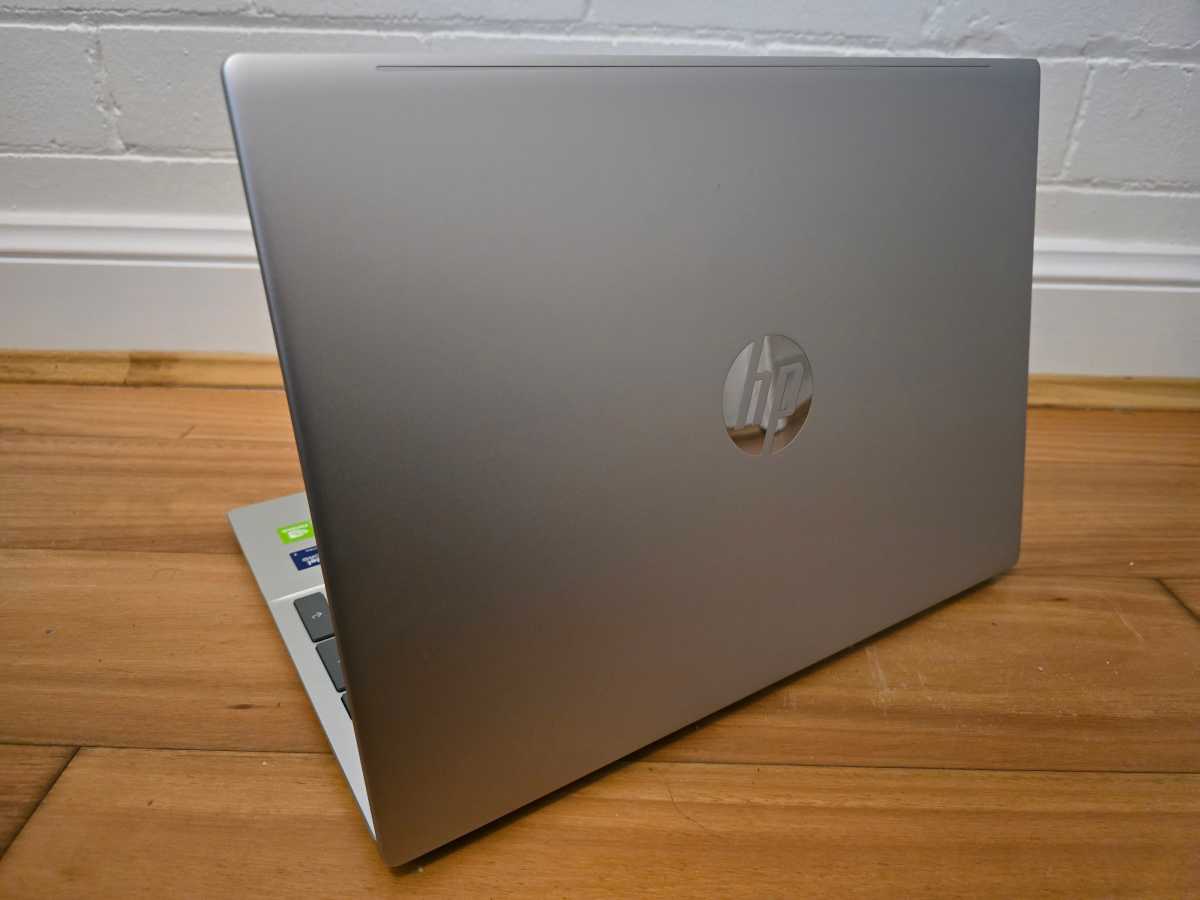
The HP Pavilion Laptop 16’s Natrual Silver color makes it versatile for home or work.
The HP Pavilion Laptop 16’s Natrual Silver color makes it versatile for home or work.
Dominic Bayley / IDG
The HP Pavilion Laptop 16’s Natrual Silver color makes it versatile for home or work.
Dominic Bayley / IDG
Dominic Bayley / IDG
While it exudes that casual practicality at every corner, it also feels quite durable. The hinges are rigid, and the lid doesn’t flex unless you apply serious pressure, both of which instill a lot of confidence that the Pavilion won’t bust up with everyday use.
HP Pavilion Laptop 16: Keyboard, trackpad
Not only is the keyboard really big, but HP has also gone to town incorporating as many useful keys as possible. You’ll still see familiar favorites like the Fn keys and Left and Right Shift keys as you might in any other large laptop’s keyboard, but you also get a full-sized numpad and dedicated Home, End, Pg Up, and Pg Down keys too.
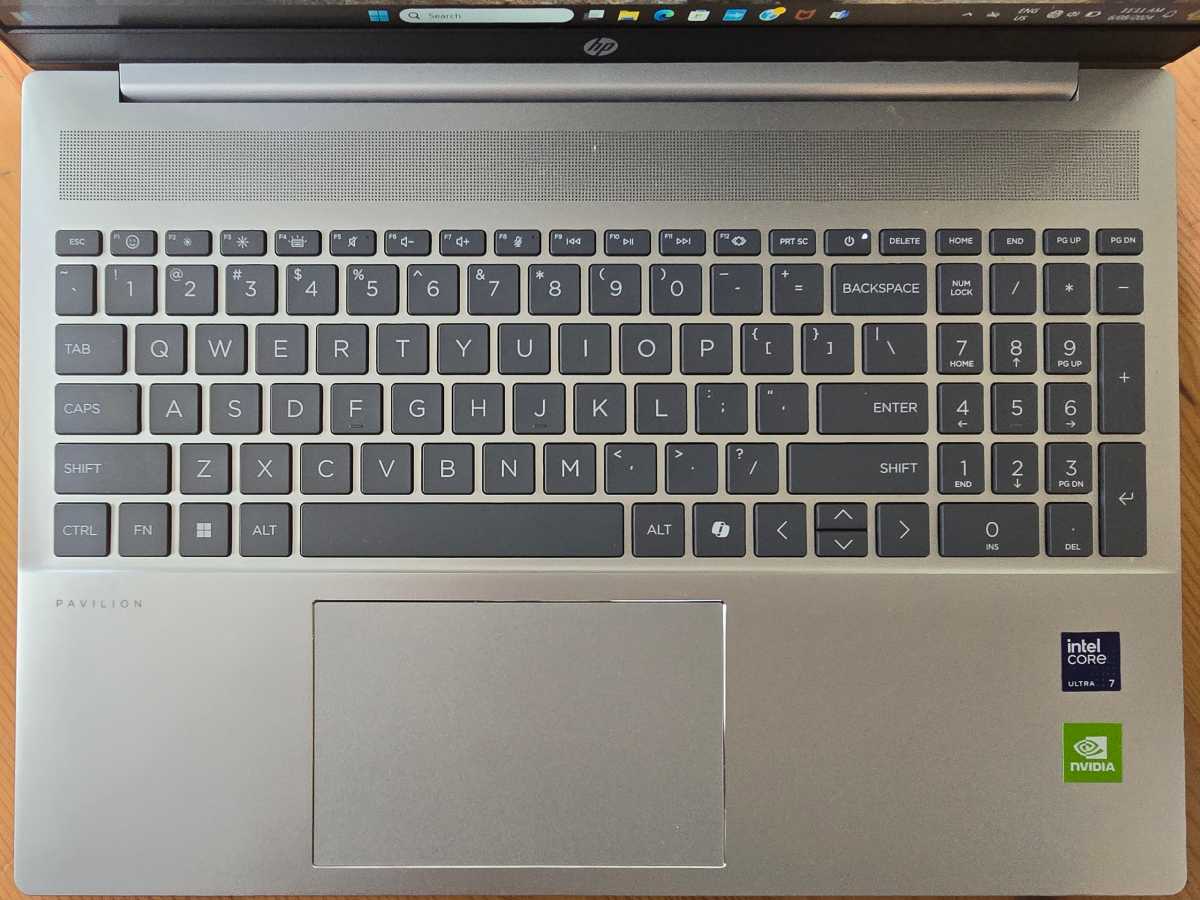
The HP Pavilion Laptop 16 has a spacious keyboard with a full-sized numpad.
The HP Pavilion Laptop 16 has a spacious keyboard with a full-sized numpad.
Dominic Bayley / IDG
The HP Pavilion Laptop 16 has a spacious keyboard with a full-sized numpad.
Dominic Bayley / IDG
Dominic Bayley / IDG
Since they’re dedicated, straining to remember which keys have these as secondary functions isn’t an issue. There’s also a Windows Copilot+ shortcut key located near the right Alt key. Microsoft Copilot+ keys are new additions to keyboards, but they do save time, so I was glad to have quick access to Microsoft’s AI assistant.
The key feel is firmer than in some laptops. I put that down to their long vertical travel and springy rebound. On the plus side, the keys are very stable – they don’t wobble or skew sideways on the down press, which makes for very accurate typing. The key backlighting is also bright and easily visible at night.
The touchpad feels solid rather than hollow. Its moderate size means there’s plenty of room either side to rest your wrists.
HP Pavilion Laptop 16: Connectivity, webcam
The laptop has two USB-C ports and two USB-A ports, which accommodated my external mouse and keyboard and my external SSD with no fuss.
That left me a USB-A port as a ‘floating port’ for USB sticks. The two USB-C ports are quite useful in that they support DisplayPort 1.4 and PowerDelivery. That means they allow you to attach extra displays or charge the laptop. The Pavilion Laptop 16 also has a HDMI 2.1 port and a 3.5 mm audio jack.
The ports are a little clustered together, which looks to have been a decision made by necessity. The laptop’s width tapers from thinnest at the front to thickest at back. Still, they are neatly arranged, which helped me manage desk space for my varied components.
Wi-Fi 6E connectivity provided my Pavilion Laptop 16 with a snappy connection for downloading the large files I needed to benchmark it. My review model also had Bluetooth 5.3 which I used to stream music from the laptop to my portable speaker.
This connectivity was quick enough to render images in live chats mostly lag free via the laptop’s 1080p IR camera. The picture I got had a natural light balance and the dual array microphones which incorporate temporal noise reduction did a decent job making my voice sound clear.
HP Pavilion Laptop 16: Display, audio
The Pavilion Laptop 16 ships with a 16-inch 1920x1200p LCD IPS-grade display. The base model is a non-touch version, but you can buy a touch-sensitive version for an extra $50 if you wish.
Summing up what I thought of the display’s visual quality, and it’s not trying to move mountains. The panel has a 65 percent RGB color, 1920x1200p resolution, and 300 nits peak brightness, which together make for no-nonsense visuals that look good but not amazing. I’ve seen a lot richer color saturation and contrast in OLED panels.
Still, while I was never wowed by the visuals, I was never unhappy with them either. Besides, the more modest specs meant there was no lag or delay playing media, videos were fluid and flicker free. The anti-glare functionality also kept reflection down to a minimum.
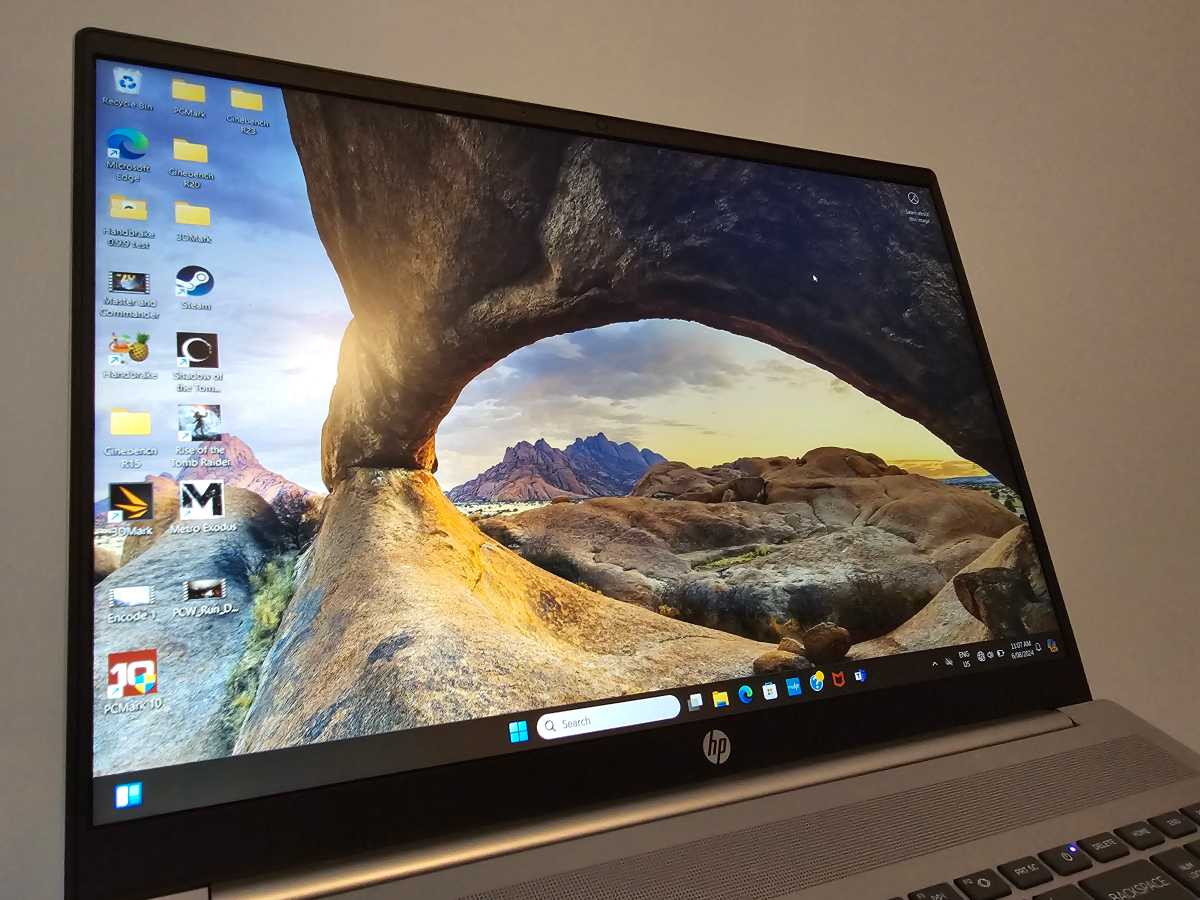
The HP Pavilion Laptop 16’s display frames up in a tall 16:10 aspect ratio.
The HP Pavilion Laptop 16’s display frames up in a tall 16:10 aspect ratio.
Dominic Bayley / IDG
The HP Pavilion Laptop 16’s display frames up in a tall 16:10 aspect ratio.
Dominic Bayley / IDG
Dominic Bayley / IDG
The best thing about the display for me was simply its huge size. It also has a 16:10 aspect ratio, so it’s a lot taller than the 16:9 aspect ratio panels in older Pavilion models. The one caveat to that extra height is that the chassis’ base is also quite large. Consequently, you’ll need a lot of desk space to house the laptop’s 14.08 x 10.03 x 0.70-inch frame.
Dual speakers sit on the underside of the chassis. They support DTS:X Ultra, which gives the audio a cinematic quality. Since they fire downwards, though, some of the detail is lost in delivery. If that becomes an issue, plugging in a good pair of external speakers or headphones will remedy that.
HP Pavilion Laptop 16: Performance
My review model’s Intel Core Ultra 7 155U is a mid-range Meteor Lake processor and comes designated with the letter “U” to denote its ultra-low power consumption. It features 12 cores and 14 threads and has a maximum turbo frequency of 4.8GHz.
The first benchmark I tested it on was Maxon’s Cinebench Multi-Threaded benchmark. This test fired all the processor’s 12 cores to simulate how it could handle a similar all-hands on-deck compute task.
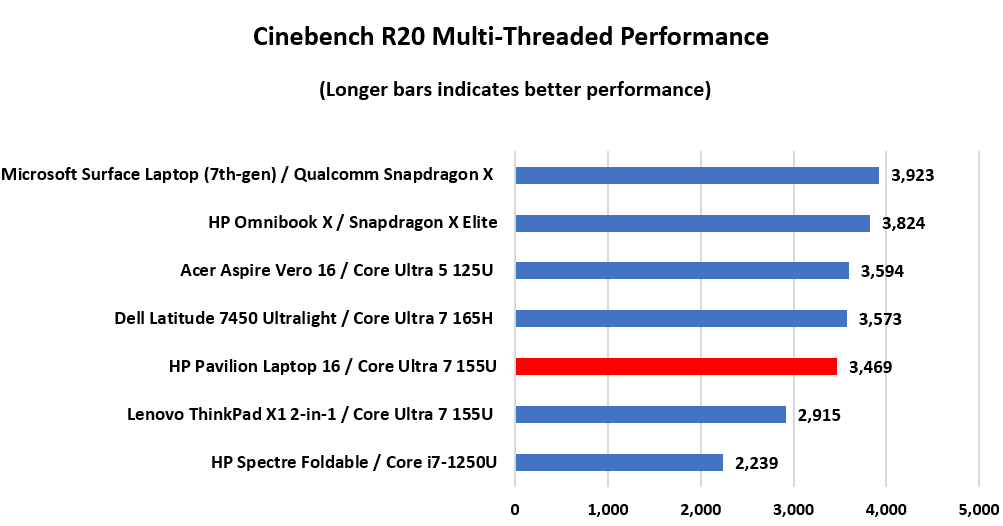
Dominic Bayley / IDG
Dominic Bayley / IDG
Dominic Bayley / IDG
As you can see, the Pavilion Laptop 16 fielded a score in the bottom one third of our comparison group. That result isn’t surprising considering that the Core Ultra 7 155U is designed for low power computing rather than intensive high-performance computing.
The Pavilion Laptop 16 did prove it can keep thermals in check to finish heavy tasks quickly, however, which even laptops with high-performance processors sometimes struggle with. I figured that from the fast time it took to finish our standard PCWorld encoding test in the Handbrake utility. This is a better result than most light and thin laptops will achieve.

Dominic Bayley / IDG
Dominic Bayley / IDG
Dominic Bayley / IDG
The PCMark benchmark provided an indication of how the Pavilion Laptop 16 might handle a range of office tasks like web browsing, opening apps, and spread sheeting.
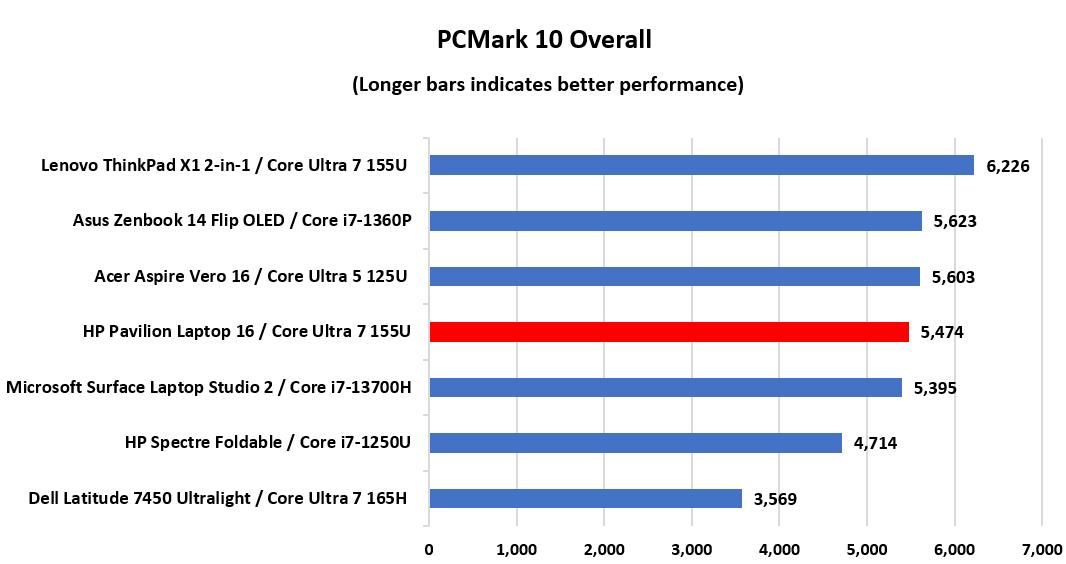
Dominic Bayley / IDG
Dominic Bayley / IDG
Dominic Bayley / IDG
To be sure, it performed very well in this benchmark, considering it’s not a specialist productivity laptop. In fact, an overall score of 5,474 means it will comfortably run office apps and breeze through most tasks.
HP Pavilion Laptop 16: Graphics performance
A lot of lightweight and thin laptops don’t have dedicated GPUs, but my Pavilion model featured a Nvidia MX570 A card. This discrete GPU is an entry-level GPU in Nvidia’s lineup, but it still supports ray-tracing and variable-rate shading, so in theory it should handle graphically demanding tasks a little better than laptops with just integrated graphics. Let’s take a look at what the benchmarks results show.
In 3DMark’s Time Spy 1.2 benchmark, the HP Pavilion Laptop 16 achieved an overall score of 3,477. This indicates it does have a slightly better graphics performance than a lot of productivity laptops with just integrated graphics, but it’s not a huge leap up in power.
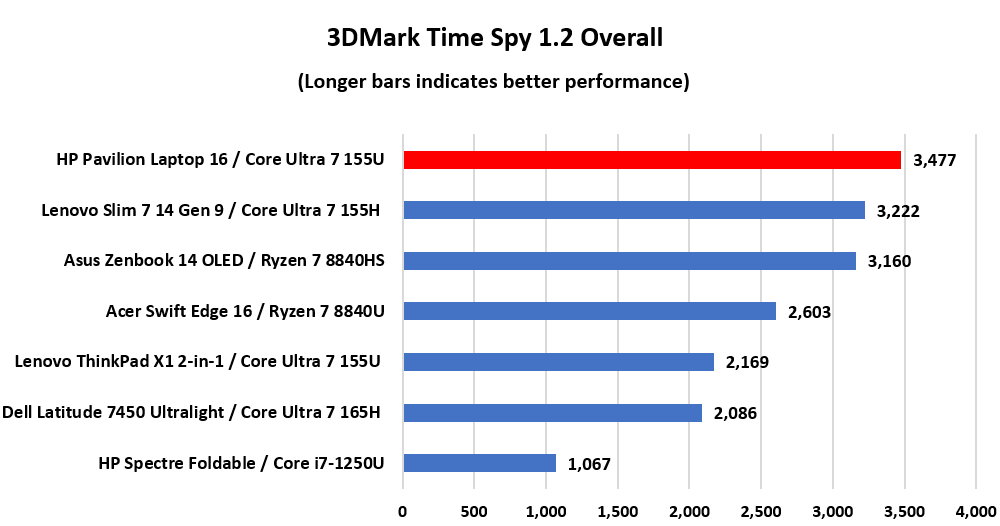
Dominic Bayley / IDG
Dominic Bayley / IDG
Dominic Bayley / IDG
Considering some gaming laptops have clocked scores as high as 20,000 this year in this same benchmark, the result is still a long way off the kind of top-line graphics performance you’d get from a laptop with one of Nvidia’s GeForce RTX 40 Series cards. That’s important to note if you plan on doing any gaming on the Pavilion Laptop 16.
Running the benchmark for the AAA game Shadow of the Tomb Raider told me a similar story. Yet again, the laptop did show slightly better graphics performance than some laptops with just integrated graphics cards – indeed, most won’t even run this benchmark (so all our comparisons feature discrete GPUs). It just didn’t clock a high average FPS score.
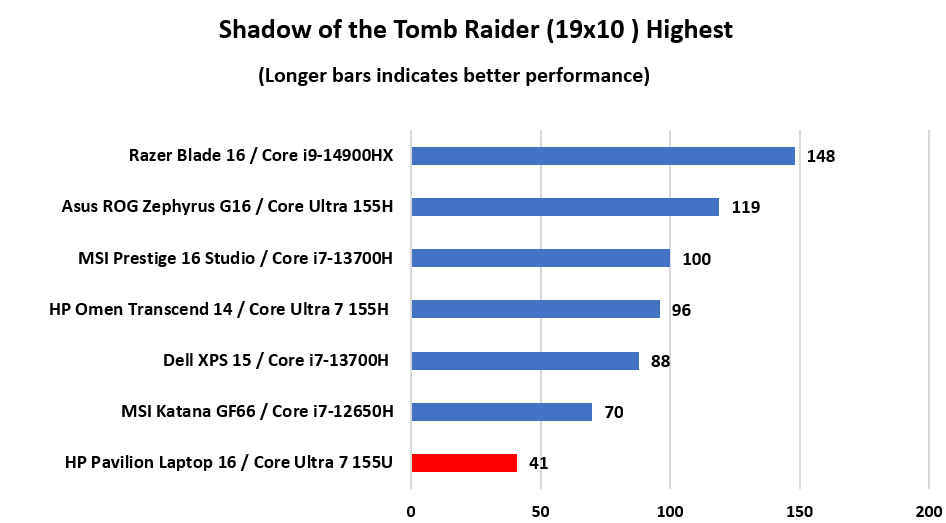
Dominic Bayley / IDG
Dominic Bayley / IDG
Dominic Bayley / IDG
These results again point to the laptop being better at tackling lightweight graphics tasks – which it will do with ease – rather than intensive tasks like what an animator or graphic designer might do.
It also means that while the GPU will play AAA titles, personally, I’d stick to playing games that won’t take too much of a performance hit – like indie games, lower resolution FPS games or platform games.
HP Pavilion Laptop 16: Battery life
To test the laptop’s battery life, I set a 30GB 4K video on repeat in the Windows Films and TV app. But first I did quite a bit of setup: I charged it to 100 percent, switched volume to 50 percent, activated airplane mode, and adjusted the brightness.
I also switched the keyboard backlighting off and plugged in a cheap pair of headphones to control sound. Just before pressing play, I unplugged the laptop from the power outlet and timed how long it took to run out of juice.
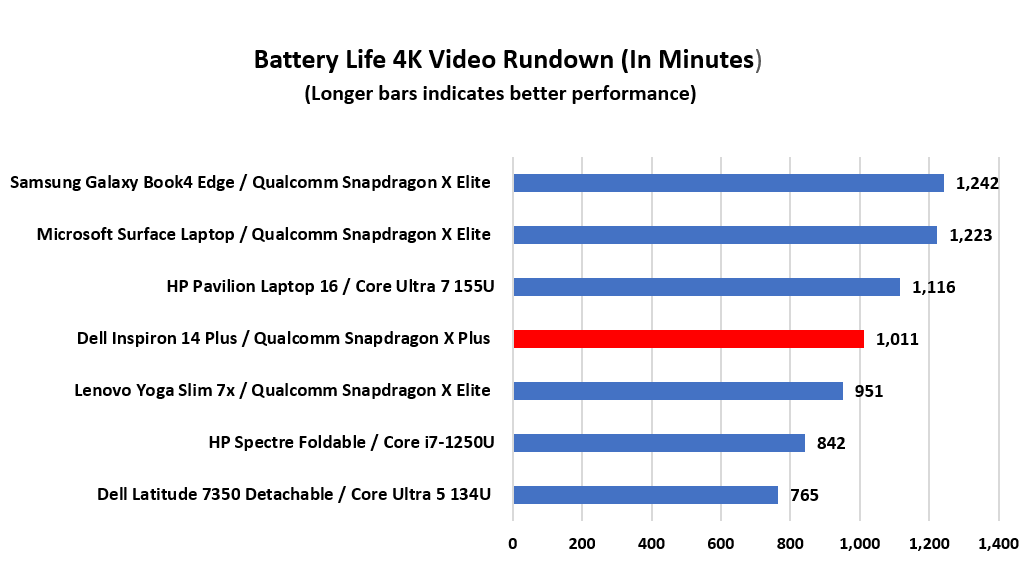
Dominic Bayley / IDG
Dominic Bayley / IDG
Dominic Bayley / IDG
As you can see in the graph, the Pavilion Laptop 16 powered down after 18 hours and 36 minutes of playtime, which encompassed a whole night and a lot of the next day.
That result was a lot better than expected, but it’s a best-case scenario. Running power hungry apps and programs might reduce that runtime to nearer 10 hours. Either way, it’s great to know the Pavilion Laptop 16 will keep going all day if you need it to.
HP Pavilion Laptop 16: Conclusion
The HP Pavilion Laptop 16 espouses the kind of big visuals and full-sized keyboard access you might find in a desktop replacement gaming laptop yet it’s as portable as an ultrabook. It also features jack-of-all-trades performance that’s just as useful for leisure as it is for a spot of work.
The Pavilion Laptop 16 can also be used for lightweight gaming where you’re best-off sticking to playing less graphically demanding titles. Indeed, if you’re looking for an affordable do-it-all with a relaxed feel, then the HP Pavilion Laptop 16 is a great choice.
Author: Dominic Bayley, PCWorld Australia Editor
Based in Australia, Dominic Bayley is a hardcore tech enthusiast. His PCWorld focus is on PC gaming hardware: laptops, mice, headsets and keyboards.
